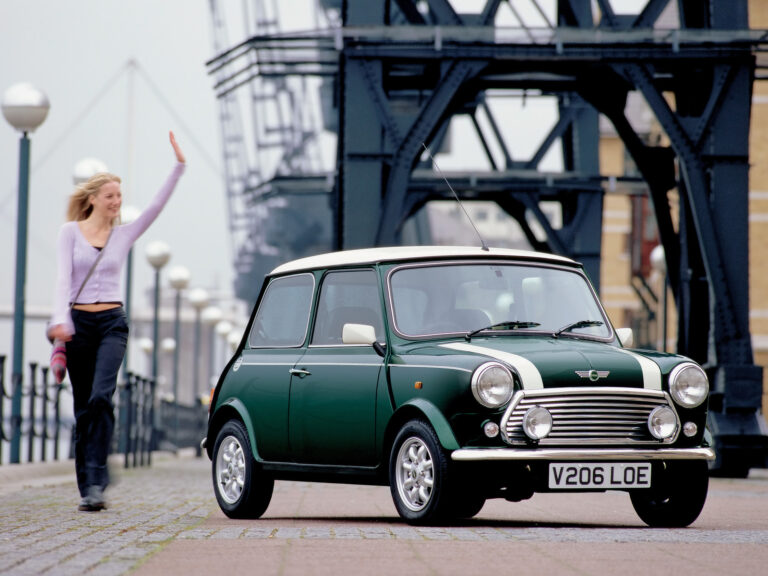When the Suez Crisis broke out in 1956, causing fuel prices to rise, British Motor Corporation (BMC) decided they needed a new, small, and economical car. The design of a compact and affordable vehicle was entrusted to the designer Alec Issigonis. Thus, in 1959, production began on the classic Mini, which was initially launched as the Austin Seven and Morris Mini-Minor. Later, due to its great success, Mini became an independent brand.
In 1961, a sporty version called the Mini Cooper was launched in collaboration with racing car manufacturer John Cooper. Two years later, an even more powerful version, the Cooper S, followed.
Back in 1959, BMC probably never imagined that the Mini would become the best-selling British car, remaining almost unchanged in production for over 40 years.
Did you know?
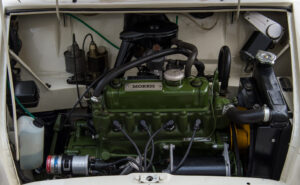 Because of the desire to create the smallest possible car that still offered the comfort of a larger vehicle, many innovative solutions were needed. Although transversely mounted engines had been used before (for example, in the Saab 92), the Mini’s design refined this concept by combining the gearbox with the engine’s oil sump. This meant that the engine and gearbox shared the same oil, allowing for a compact power unit narrow enough to fit into such a small car.
Because of the desire to create the smallest possible car that still offered the comfort of a larger vehicle, many innovative solutions were needed. Although transversely mounted engines had been used before (for example, in the Saab 92), the Mini’s design refined this concept by combining the gearbox with the engine’s oil sump. This meant that the engine and gearbox shared the same oil, allowing for a compact power unit narrow enough to fit into such a small car.
Although this engine layout was unusual at the time, nearly all small front-wheel-drive cars developed later used a similar design.
Of course, this design wasn’t without its drawbacks. The radiator with its fan was mounted on the left side of the car, so the fan blew air into a naturally low-pressure area under the front wing. While this saved space, it also meant the radiator received air that had already been warmed by the engine. Additionally, the entire ignition system wiring was exposed to direct rainfall through the grille.- They also saved space inside the car — instead of traditional roll-down windows, the first Minis had sliding windows, which saved room inside the doors and allowed for extra storage compartments. Interestingly, where you would normally expect to find a radio, the early models had an ashtray instead — Alec Issigonis believed that an ashtray was more important to the driver than music.
Dunlop specially developed small 10-inch tires for the Mini, as nothing existing at the time was suitable.
Thanks to clever design features like small wheels, thin seats, and minimal engine space, as much as 80% of the car’s total length was dedicated to the passenger cabin.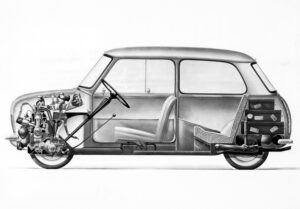
The result was a car only 305 cm long and 120 cm wide, yet still spacious enough to seat four people.
- When the Mini was launched in 1959, it produced 34 horsepower, which was enough for such a small car. Initially, BMC was hesitant about John Cooper’s idea to create a faster version — they believed the Mini was simply a practical and affordable car without any sporting potential. However, after some persuasion, the Mini Cooper version was introduced in 1961 with a more powerful engine (55 hp) and new front disc brakes.
Due to the success of the Mini Cooper, an even sportier Cooper S model was introduced in 1963, boasting an engine that produced 70 horsepower. This was an exceptional combination given the car’s weight (only about 650 kilograms) and excellent handling on the road. The Cooper S featured an additional oil cooler, an extra fuel tank on the right side, and improved power-assisted disc brakes.
The interior of these sporty models didn’t differ much from the basic versions — the seats, dashboard, and materials remained modest and practical, which some buyers found a bit too simple. - The Mini Cooper S won the Monte Carlo Rally three times — in 1964, 1965, and 1967. It also dominated in 1966, finishing in first place, but was disqualified due to incorrect front headlights. As a result, the victory was officially awarded to Pauli Toivonen in a Citroën DS, who, however, refused to accept the prize. This event is considered one of the most controversial moments in rally history. Had the disqualification not occurred, the Mini would have achieved four consecutive wins at the Monte Carlo Rally.
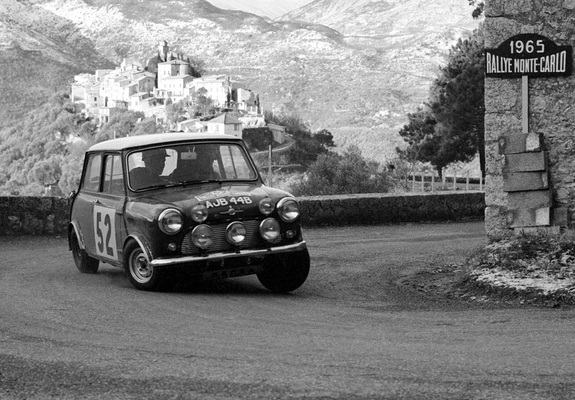
- The Mini also captured the enthusiasm of several famous people.
All members of The Beatles owned their own Minis, which were custom-modified by Radford — a company known for luxury and unique conversions. The most special was Ringo Starr’s Mini, a dark red Cooper S with lavish features and even custom rear doors to fit his drum kit inside. In 2017, this car sold at auction for £102,000. Paul McCartney opted for a more refined version in Aston Martin’s “California Sage” color. His Mini was sold in 2018 for £183,500.
You can read more about their Minis in this article.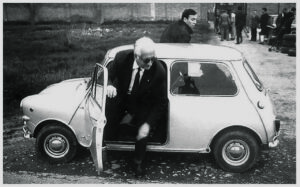 Even Enzo Ferrari owned one. One of his cars was a specially modified Mini Cooper 1300 S — personally presented to him by Alec Issigonis.
Even Enzo Ferrari owned one. One of his cars was a specially modified Mini Cooper 1300 S — personally presented to him by Alec Issigonis.
- The Mini also played an important role on the big screen. It is especially memorable in the film The Italian Job (1969), where one of the most iconic car chases happens near the end — three Mini Coopers, loaded with stolen gold, flee from the police through narrow Italian streets, over rooftops, and even through the sewer system. Dozens of Minis were used during filming, most of which were heavily damaged by the end of the shoot. Thanks to this scene, the car became an even bigger legend. In 2003, a modern remake of the film was made, featuring the then-new Minis.
The Mini also became iconic thanks to the Mr. Bean series. Mr. Bean’s Mini appeared in several different colors — in the first episode, it was orange, while in later episodes it took on the recognizable yellow color. It was an important part of the show, as Mr. Bean often used it to demonstrate safe driving (see image). The series was hugely successful, spawning animated spin-offs and films, with the Mini becoming an inseparable symbol of the franchise.
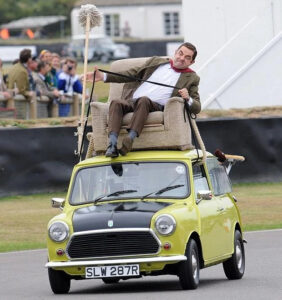
- Over its 40 years of production, many different Mini versions were created to suit various customer needs. In 1960, the Austin Seven Countryman was launched — a station wagon version of the Mini with wooden trim on the rear section, earning it the nickname “Woody.” That same year, the Mini Van was introduced, an extended and simplified delivery version offering more cargo space. A year later came the Mini Pick-up, which shared its front end with the van but had an open rear bed for transporting goods.
In 1964, the Mini Moke was born — a simple off-road vehicle originally intended for military use. Instead it became popular on beaches and in tourist areas. In the 1990s, the Mini even received a convertible version, which stood out with a special body kit, leather interior trim, and exclusive alloy wheels.
- Over its 40 years of production, many different Mini versions were created to suit various customer needs. In 1960, the Austin Seven Countryman was launched — a station wagon version of the Mini with wooden trim on the rear section, earning it the nickname “Woody.” That same year, the Mini Van was introduced, an extended and simplified delivery version offering more cargo space. A year later came the Mini Pick-up, which shared its front end with the van but had an open rear bed for transporting goods.
You can read more about all the different versions of the Mini here.
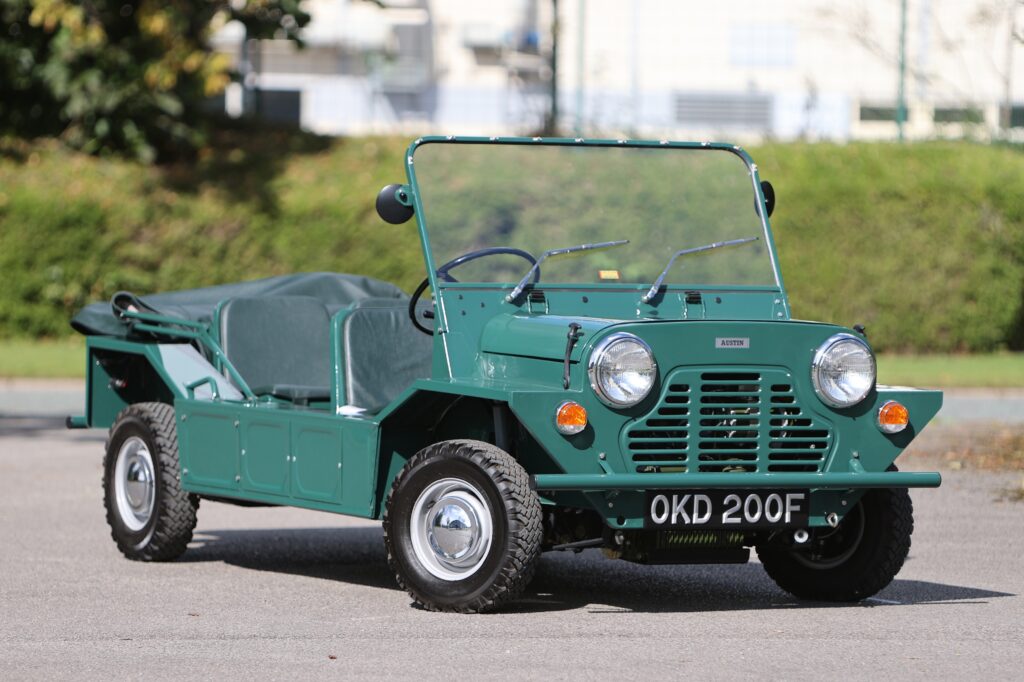
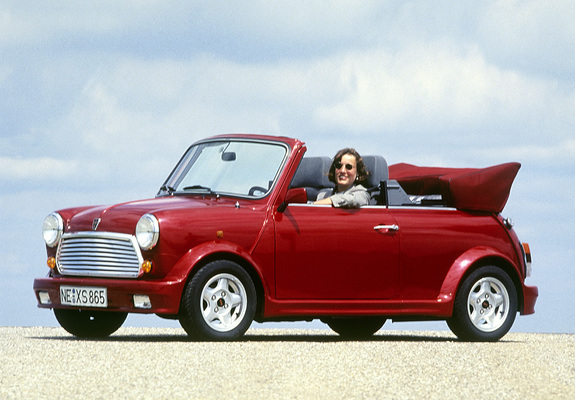
The Mini is without a doubt one of the most recognizable cars in history. Its combination of simplicity and innovation captivated people around the world — from everyday drivers to celebrities and racers. Between 1959 and 2000, more than 5.3 million units were produced. Even more remarkable is the fact that the Mini stayed on the market for four decades without major design changes, a testament to how advanced and well-executed the original concept was. Today, the Mini remains a symbol of British design, automotive ingenuity, and lasting popularity.
